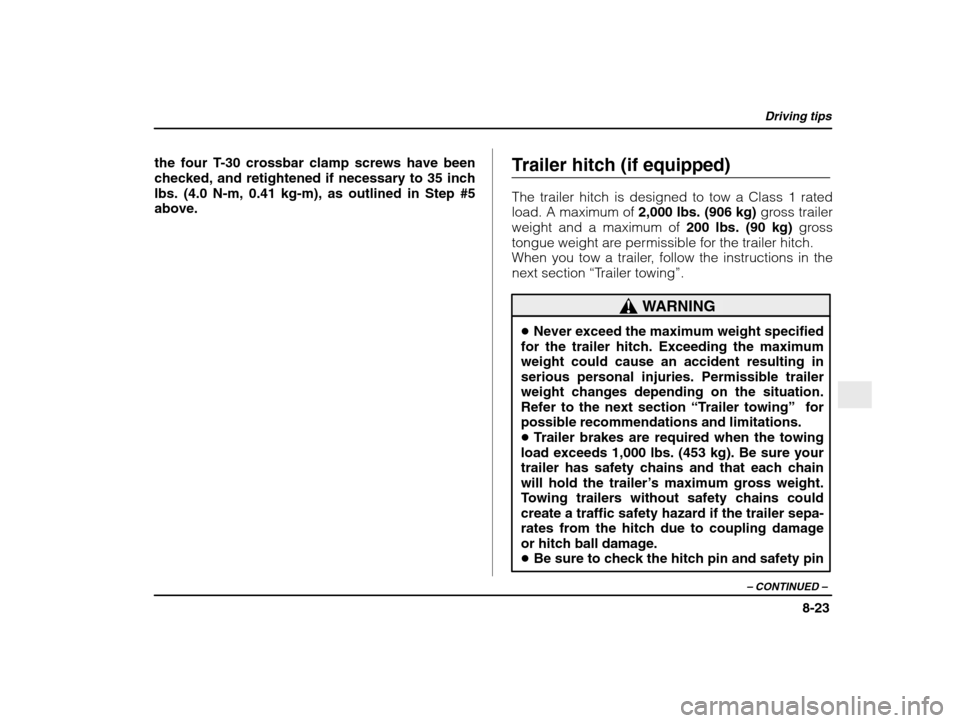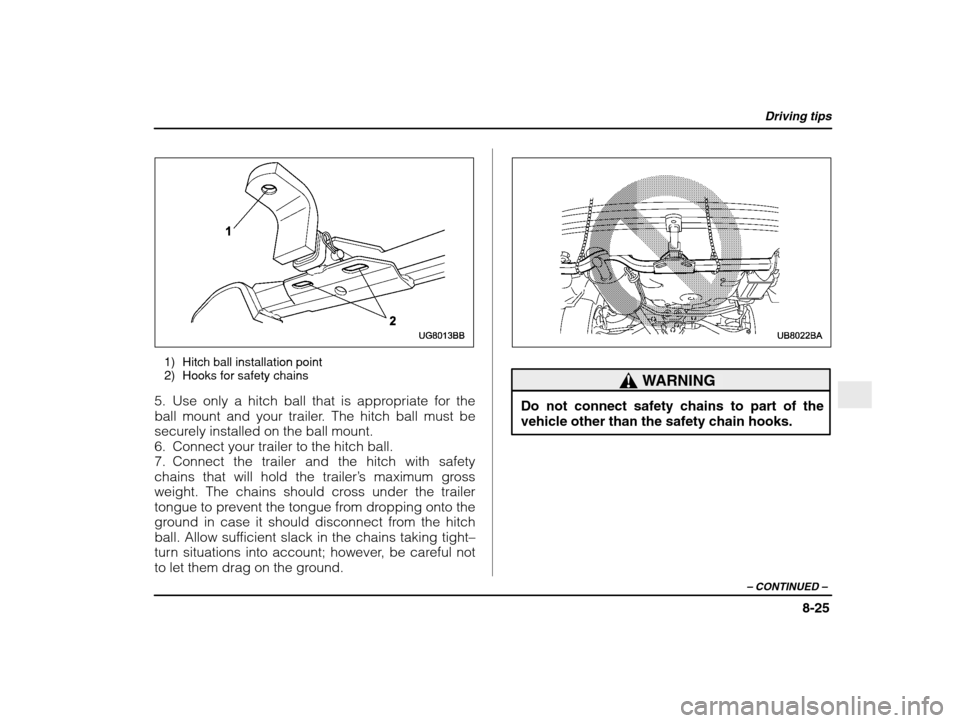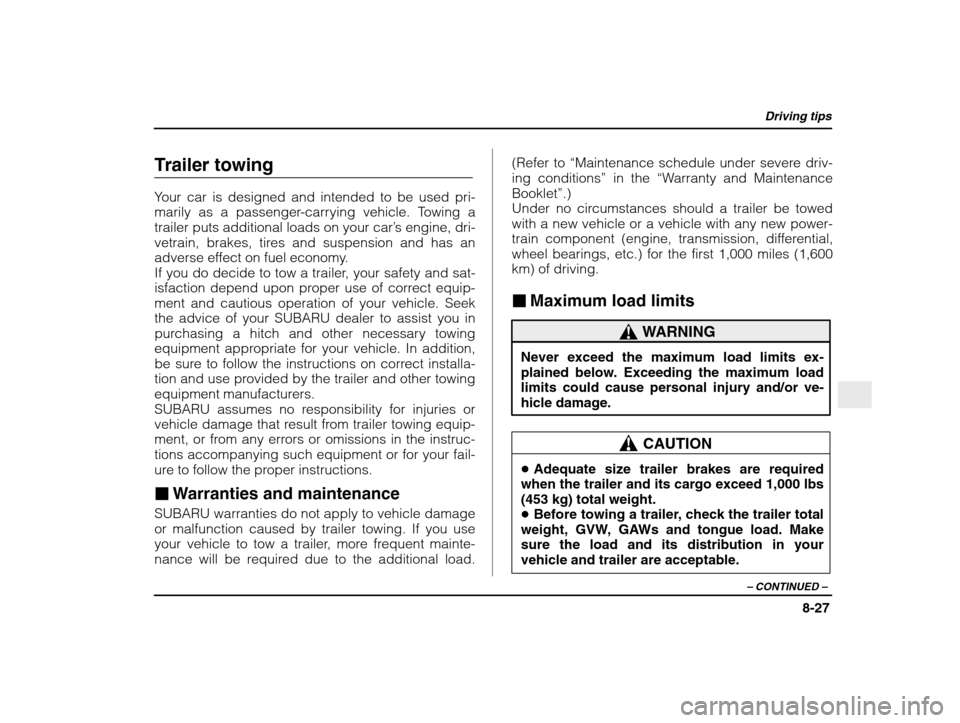SUBARU IMPREZA WRX 2003 2.G Owners Manual
Manufacturer: SUBARU, Model Year: 2003, Model line: IMPREZA WRX, Model: SUBARU IMPREZA WRX 2003 2.GPages: 425, PDF Size: 5.75 MB
Page 271 of 425

Driving tips
8-18
load. Therefore, the GVW changes depending on
the situation. The GVWR equals Curb Weight (actualweight of your vehicle – including standard equip-
ment, fluids, emergency tools and spare tire assem-bly) plus the vehicle capacity weight. In addition, the total weight applied to each axle
(GAW) must never exceed the GAWR. The front and
rear GAWs can be adjusted by relocating luggageinside the vehicle.Even if the total weight of your luggage is lower than
the vehicle capacity weight, either front or rear GAW
may exceed the GAWR, depending on the distribu-
tion of the luggage.
If you carry heavy loads in the vehicle, you should
confirm that GVW and front and rear GAWs are with-
in the GVWR and GAWR by putting your vehicle on
a vehicle scale, found at a commercial weighing sta- tion.
Do not use replacement tires with a lower load range than the originals because they may lower the
GVWR and GAWR limitations. Replacement tireswith a higher load range than the originals do not in-
crease the GVWR and GAWR limitations. �
Roof rail and crossbar (if equipped)
1) Crossbar kit
The roof rail is not designed to carry cargo by itself.
Cargo can be carried after securing the roof cross-
bar kit to the roof rail and installing the appropriate
carrying attachment. When installing the roof cross-
bar kit, follow the manufacturer ’s instructions.
When you carry cargo on the roof using the roof
crossbar kit and a carrying attachment, never ex-
ceed the maximum load limit explained below. You
should also be careful that your vehicle does not ex-
ceed the Gross Vehicle Weight Rating (GVWR) and
Page 272 of 425

Driving tips
8-19
– CONTINUED –
front and rear Gross Axle Weight Rating (GAWR). See the “Loading your vehicle ” section in this chap-
ter for information on loading cargo into or onto your
vehicle. The maximum load limit of the cargo, cross-
bars and carrying attachment must not exceed 100
lb. (45 kg). Place the heaviest load at the bottom,
nearest the roof, and evenly distribute the cargo. Al-
ways properly secure all cargo.
CAUTION
� For cargo carrying purposes, the roof rail
must be used together with a roof crossbar kit and the appropriate carrying attachment. The roof rail must never be used alone to carrycargo. Otherwise, damage to the roof or paint
or a dangerous road hazard due to loss of car-go could result.� When using the roof crossbar kit, make sure
that the total weight of the crossbars, carryingattachment and cargo does not exceed the
maximum load limit. Overloading may cause
damage to the vehicle and create a safety haz-ard. �
Installing carrying attachments on the cross-bars
When installing any carrying attachment such as a
bike carrier, ski carrier, kayak carrier, cargo basket,
etc. on the crossbars, follow the manufacturer ’s
instructions and make sure that the attachment is
securely fixed to the crossbars. Use only attach-
ments designed specifically for the crossbars. A set
of the crossbars is designed to carry loads (cargo
and attachment) of not more than 100 lb. (45 kg).
Before operating the vehicle, make sure that the car-
go is properly secured on the attachment. NOTE Remember that the vehicle ’s center of gravity is
altered with the weight of the load on the roof, thus affecting the driving characteristics.
Drive carefully. Avoid rapid starts, hard corneringand abrupt stops. Crosswind effects will beincreased.
� Removal and installation of the crossbars
The crossbars can be removed when you do not
use the roof to carry cargo.
n To remove the crossbar
1. Loosen and remove the T –30 torx � head screw
from the top of each crossbar end support.
Page 273 of 425

Driving tips
8-20
2. Rotate the lower clamp on the bottom of each
end support downward approximately 90°.
3. Carefully raise the crossbar from roof rails.
n To install the crossbar
Front crossbar:
Front crossbar has 100 LBS. Load Label on left-hand side.
Page 274 of 425

Driving tips
8-21
– CONTINUED –
F) Front of vehicle
1) T30 torx� head screw
2) Front arrow label
3) Front crossbar
4) 100LBS load label
5) Lower clamp
6) Roof rail end support
7) Joint line
8) 3 inches (76 mm)
9) Front arrow label
1. Before placing the crossbar on the roof rails,
make sure that the T-30 torx � head screw is
removed from the top of each crossbar end support.
2. Rotate the lower clamp on the bottom of each
end support downward approximately 90 °.
3. With the front direction arrow label on the top
right side of the crossbar pointing toward the front of
the vehicle, carefully place the crossbar across the
top of the vehicle so that the crossbar end supports
rest on the top of the roof rails approximately 3
inches (76 mm) rearward from the seam (joint)
between the front roof rail support and the roof rail.
4. Rotate (raise) the lower clamp up to the bottom of
the roof rail and loosely tighten the T-30 torx � head
screw with the torx � wrench provided, through the
top of the end support and into the threaded insert
in the lower clamp on each end of the crossbar. NOTE It may be necessary to squeeze the lower clamp and the end support together to compress thepads and gain a better alignment of the pieces
while trying to start the screw. Use care not tocrossthread the screw in the insert.
5. Adjust the alignment of the crossbar on the roof
rails, and if available, use a T-30 torx
� bit and
torque wrench and tighten the T-30 torx � head
screws to 30 to 35 inch lbs. (3.4 to 4.0 N-m, 0.35 to
0.41 kg-m) of torque (or tighten securely with thetorx � wrench provided).
Page 275 of 425

Driving tips
8-22
Rear crossbar:F) Front of vehicle
1) T30 torx� head screw
2) Front arrow label
3) Rear crossbar
4) 0 inch (0 mm)
5) Roof rail end support
6) Joint line
7) Front arrow label
Install the rear crossbar in the same manner as the
front crossbar. NOTE The rear crossbar should be positioned just in front of the rear seam (joint) between the rear roof rail support and the roof rail.
CAUTION
Do not carry cargo on the roof when the crossbars are removed. Luggage on the roofwill be thrown forward or backward in sudden
stops or rapid accelerations, resulting in a dangerous road hazard.
NOTE
Before each use of the roof crossbar, make sure
Page 276 of 425

Driving tips
8-23
– CONTINUED –
the four T-30 crossbar clamp screws have been
checked, and retightened if necessary to 35 inch
lbs. (4.0 N-m, 0.41 kg-m), as outlined in Step #5above. Trailer hitch (if equipped) The trailer hitch is designed to tow a Class 1 rated
load. A maximum of
2,000 lbs. (906 kg) gross trailer
weight and a maximum of 200 lbs. (90 kg) gross
tongue weight are permissible for the trailer hitch.
When you tow a trailer, follow the instructions in the next section “Trailer towing ”.
WARNING
�Never exceed the maximum weight specified
for the trailer hitch. Exceeding the maximum weight could cause an accident resulting inserious personal injuries. Permissible trailerweight changes depending on the situation.Refer to the next section “Trailer towing ” for
possible recommendations and limitations.� Trailer brakes are required when the towing
load exceeds 1,000 lbs. (453 kg). Be sure yourtrailer has safety chains and that each chainwill hold the trailer ’s maximum gross weight.
Towing trailers without safety chains could create a traffic safety hazard if the trailer sepa- rates from the hitch due to coupling damageor hitch ball damage.� Be sure to check the hitch pin and safety pin
Page 277 of 425

Driving tips
8-24
for positive locking placement before towing a
trailer. If the ball mount comes off the hitch re-
ceiver, the trailer could get loose and create atraffic safety hazard.�Use only the ball mount supplied with this
hitch. Use the hitch only as a weight carrying
hitch. Do not use with any type of weight dis- tributing hitch.
� Connecting a trailer
1. Remove the receiver cover from the hitch receiv-
er tube. Then insert the ball mount into the hitch re- ceiver tube.2. Insert the hitch pin into the hole on the hitch re-
ceiver tube so that the pin passes through the ballmount.
3. Insert the safety pin securely into the hitch pin.
4. Pull the ball mount to make sure it does not come
off the hitch receiver.
Page 278 of 425

Driving tips
8-25
– CONTINUED –
1) Hitch ball installation point
2) Hooks for safety chains
5. Use only a hitch ball that is appropriate for the
ball mount and your trailer. The hitch ball must be
securely installed on the ball mount.
6. Connect your trailer to the hitch ball.
7. Connect the trailer and the hitch with safetychains that will hold the trailer ’s maximum gross
weight. The chains should cross under the trailer
tongue to prevent the tongue from dropping onto the
ground in case it should disconnect from the hitch
ball. Allow sufficient slack in the chains taking tight –
turn situations into account; however, be careful not
to let them drag on the ground.
WARNING
Do not connect safety chains to part of the
vehicle other than the safety chain hooks.
Page 279 of 425

Driving tips
8-26
Hitch harness connector – Wagon
8. Connect the hitch wire harness ’s black four –pin
wire connector to the towing trailer ’s wire harness
9. Confirm proper function of the hitch wire harness
by individually activating the brake, right turn signal,
left turn signal, stop, and parking lights on the trailer. NOTE Always disconnect the trailer wire harness be- fore launching or retrieving a watercraft. � When you do not tow a trailer
� Remove the ball mount from the hitch receiver
tube and insert the receiver cover onto the hitch re- ceiver tube. �
Place the dust cap over the four –pin connector of
the hitch wire harness to protect against possibledamage.� Occasionally lubricate terminals of the four –pin
connector using terminal grease.
Page 280 of 425

Driving tips
8-27
– CONTINUED –
Trailer towing
Your car is designed and intended to be used pri-
marily as a passenger-carrying vehicle. Towing a
trailer puts additional loads on your car ’s engine, dri-
vetrain, brakes, tires and suspension and has an
adverse effect on fuel economy.
If you do decide to tow a trailer, your safety and sat-
isfaction depend upon proper use of correct equip-
ment and cautious operation of your vehicle. Seekthe advice of your SUBARU dealer to assist you in
purchasing a hitch and other necessary towing
equipment appropriate for your vehicle. In addition,
be sure to follow the instructions on correct installa-
tion and use provided by the trailer and other towing
equipment manufacturers.
SUBARU assumes no responsibility for injuries or
vehicle damage that result from trailer towing equip-
ment, or from any errors or omissions in the instruc- tions accompanying such equipment or for your fail-
ure to follow the proper instructions. � Warranties and maintenance
SUBARU warranties do not apply to vehicle damage or malfunction caused by trailer towing. If you use
your vehicle to tow a trailer, more frequent mainte-
nance will be required due to the additional load. (Refer to
“Maintenance schedule under severe driv-
ing conditions ” in the “Warranty and Maintenance
Booklet”.)
Under no circumstances should a trailer be towedwith a new vehicle or a vehicle with any new power-
train component (engine, transmission, differential, wheel bearings, etc.) for the first 1,000 miles (1,600 km) of driving. � Maximum load limits
WARNING
Never exceed the maximum load limits ex-
plained below. Exceeding the maximum loadlimits could cause personal injury and/or ve-hicle damage.
CAUTION
�Adequate size trailer brakes are required
when the trailer and its cargo exceed 1,000 lbs (453 kg) total weight. � Before towing a trailer, check the trailer total
weight, GVW, GAWs and tongue load. Make sure the load and its distribution in your
vehicle and trailer are acceptable.